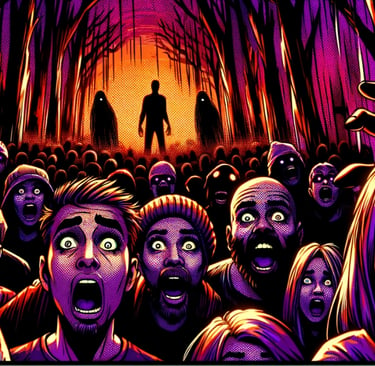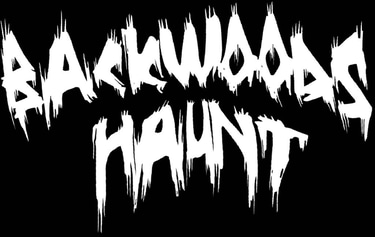Kids vs. Adults: Who Actually Scares Easier?
The Great Scare Survey
7/25/20255 min read



Kids vs. Adults: Who Actually Scares Easier?
After years of watching thousands of visitors scream their way through Backwoods Haunt, we've collected enough data to settle one of life's great debates: who scares easier, kids or adults? The answer might surprise you – and it definitely surprised us.
Spoiler alert: it's complicated, and absolutely hilarious.
The Great Scare Survey
Let's start with the numbers. Over the past three seasons, we've observed roughly 60% adults and 40% kids (we're talking teenagers here – little ones stay home where it's safe). You'd think the adults would be the brave ones, right? They've got life experience, they know it's all fake, they understand the mechanics of a haunted house.
You'd be wrong.
Round 1: Initial Reactions
Kids (Ages 13-17) Teenagers approach our haunt with a fascinating mix of bravado and terror. They talk a big game in the parking lot, usually trying to impress their friends or that person they have a crush on. But the moment our first actor jumps out, about 70% of them let out screams that could shatter glass.
However – and this is crucial – they recover fast. Like, impressively fast. Within seconds, they're laughing, pushing each other toward the next scare, and turning the whole experience into a social event.
Adults (Ages 18+) Adults enter with what we call "controlled confidence." They've done the mental math: it's actors, it's fake, it's perfectly safe. They're ready for this.
Then our chainsaw-wielding maniac (sans actual chainsaw, obviously) comes charging out of the corn maze, and suddenly that 35-year-old accountant is shrieking like they just discovered their tax return was audited.
But here's the kicker – adults stay scared longer. They don't bounce back as quickly as kids do.
Winner: Adults scare easier on first contact
Round 2: Recovery Time
Kids Teenagers have the emotional resilience of rubber balls. They scream, they jump, they grab onto their friends, and then immediately start analyzing what just happened. "Oh my god, did you see how he came out of that tree? That was so cool! Do it again!"
They turn fear into entertainment almost instantly. It's like their brains are wired to convert terror into social bonding opportunities.
Adults Adults need processing time. That jump scare doesn't just startle them – it triggers their fight-or-flight response, gets their heart racing, and activates all those primitive survival instincts they thought they'd evolved past.
We've watched grown adults stand frozen for 30 seconds after a scare, trying to convince their nervous system that they're not actually about to be eaten by a zombie.
Winner: Kids bounce back faster
Round 3: Anticipation Anxiety
Kids Here's where it gets interesting. Kids are terrible at managing anticipation. They know something is coming – they can feel it building – but they can't help themselves from walking right into it anyway.
They're like horror movie characters who investigate the scary noise in the basement. They know it's a bad idea, but they're going to do it anyway because curiosity wins over caution every single time.
Adults Adults are anticipation anxiety champions. They've seen enough horror movies to know the patterns. They recognize the setup, they can sense when a scare is coming, and they spend the entire approach dreading it.
This means they're often more terrified of what might happen than what actually does happen. Their imagination becomes our best ally.
Winner: Adults psych themselves out more effectively
Round 4: Group Dynamics
Kids Teenagers in groups are fascinating to watch. They operate like a pack, feeding off each other's energy. One person's scream becomes everyone's scream. One person's laughter breaks the tension for the whole group.
They also have zero shame about using each other as human shields. We've seen friendships tested when someone pushes their bestie toward the monster to save themselves.
Adults Adult groups are more complex. You've got the self-appointed leader trying to keep everyone calm, the comic relief person making jokes to deal with the tension, and inevitably someone who's clearly regretting their life choices.
Adults also engage in more sophisticated psychological warfare with each other. "Oh, this next part isn't that scary," followed immediately by the worst scare of the night. Friends can be cruel.
Winner: Tie – both groups are equally entertaining for different reasons
The Surprising Truth
After years of observation, here's what we've learned: kids might scream louder and more often, but adults are actually more genuinely frightened.
Kids treat our haunt like an extreme sport. They're here for the adrenaline rush, the social experience, and the bragging rights. Fear is part of the fun, not something to be avoided.
Adults often seem surprised by how scared they get. They came expecting a mild thrill and found themselves confronting fears they didn't know they still had. Many adults leave looking slightly shell-shocked, like they just learned something about themselves they weren't prepared for.
The Science Behind the Screams
Why Kids Recover Faster Teenage brains are still developing, particularly the prefrontal cortex that handles emotional regulation. Paradoxically, this makes them both more reactive (bigger screams) and more resilient (faster recovery).
Why Adults Stay Scared Longer Adult brains are better at recognizing patterns and making connections. This means they're constantly trying to predict what's coming next, which keeps their anxiety levels elevated throughout the entire experience.
Our Favorite Observations
The Parent Trap Nothing is funnier than watching a parent try to maintain their dignity while being absolutely terrified. We've seen dads sprint away from our monsters while yelling "I'm just checking if the path is safe for you kids!"
The Tough Guy Phenomenon The bigger they are, the louder they scream. Those muscle-bound guys who swagger in talking about how haunted houses don't scare them? They're usually our best customers for high-pitched shrieking.
The Unexpected Heroes Sometimes the person you'd least expect becomes the group's rock. We've watched 90-pound teenagers calmly lead groups of terrified adults through our scariest scenes.
So Who Wins?
In terms of pure entertainment value for our actors, it's a tie. Kids provide volume and energy, while adults provide sustained terror and more complex reactions.
But if we're talking about who actually gets more scared – as in genuinely frightened rather than just startled – adults take the crown. They might not scream as loudly or as often, but they experience deeper, longer-lasting fear.
Kids are playing a game. Adults are having an experience.
The Bottom Line
Whether you're 15 or 50, you're going to get scared at Backwoods Haunt. The question isn't whether you'll scream – it's what kind of screamer you'll turn out to be.
Will you be the teenager who shrieks at everything and loves every second of it? Or the adult who discovers that despite years of "maturity," you're still afraid of things that go bump in the night?
Either way, we can't wait to find out. And neither can you, even if you don't know it yet.
Come test our theories for yourself. We promise we'll be taking notes on your reactions – you know, for science.


